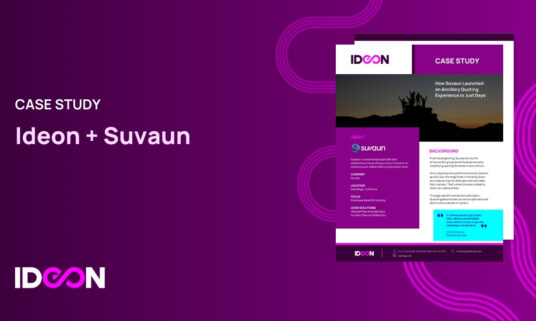Ideon Blog
August 14, 2024
By: Ideon
How carriers use quoting platforms to boost ancillary benefits sales

Summary
Market-leading ancillary and voluntary benefits carriers are leveraging digital quoting platforms to increase sales and expand their reach. These platforms simplify the quoting process for brokers, particularly in the small group market, and connect carriers to new opportunities, By integrating with these platforms, carriers are ensuring their products get more visibility and fostering stronger broker relationships.
A growing number of carriers selling ancillary products for employee benefits are overcoming initial concerns about third-party quoting platforms, embracing them and discovering a significant source of incremental sales.
In the earliest days of these platforms — which enable brokers to gather quotes from multiple carriers — some insurers were concerned that their products would be reduced to a line on a spreadsheet. They wanted brokers to continue to get quotes from their reps or their websites, allowing them to build a relationship with agents and highlight the unique benefits of their products.
Brokers, though, resisted the time-consuming process of gathering multiple quotes one at a time. Many had already used quoting platforms in personal and commercial lines and wanted the same convenience when pitching benefits plans. The platforms make preparing a client proposal much faster, and typically integrate quite well with agency management systems.
Although brokers initially used the benefits quoting platforms to manage the complexity of group health policies, many appreciated how the platforms also streamlined quoting for ancillary products. They could find the right plans and add them to a proposal in a few clicks.
The result: Carriers that chose to work with the quoting platforms discovered that they’re generating incremental sales. Rather than undercutting their existing relationships, the platforms connected carriers to brokers they had never worked with before.
Success stories: Carriers are thriving by partnering with quoting platforms
Principal Financial Group, for example, began distributing through quoting platforms as part of a strategy to convince brokers to add its ancillary products to group medical proposals. “A lot of brokers are finding their medical compensation is getting squished, so we can make it easy for them to add more lines of coverage,” said Eric Weiford, a senior relationship manager at Principal, in an Ideon webinar.
“Platforms are not the enemy,” he added. “They get more eyes on our products from people who don’t know us today but will in the future.”
The advantage is particularly powerful in the small group market, where the efficiency of quoting through platforms radically improves the economics for both brokers and carriers.
“Efficiency is king, especially with small groups,” Elek Pew, Head of Digital Partnerships at Beam Benefits, told Ideon. “We pride ourselves on meeting distributors where they are. If they use a third-party system to quote business, we’ll find a way to integrate with that platform.”
Beam’s modern, digitally-native systems and APIs allow it to generate custom quotes for any size group, even when it is connecting to brokers through a third-party platform.
“There’s a huge opportunity to deliver real-time, custom underwritten rates to small groups, especially through quoting platforms,” said Hannah Thompson, a Beam senior solutions architecture manager, in the webinar. “We can provide really sharp rates that only large groups could benefit from in the past.”
Exploring the quoting platform landscape
More quoting platforms are entering the market each year, bringing a range of tools designed to enhance the quoting process for brokers and carriers alike. Some of the existing platforms in this space include:
Additionally, some brokerages, such as Word & Brown, have developed their own proprietary platforms to further streamline the quoting process.
Getting started: Integrating with quoting platforms
Before carriers start working with benefit quoting platforms, they must decide how they will distribute their product details and rates. Those with up-to-date systems can connect in real time over an API. Carriers can also send their rates to the platforms in spreadsheets or other formats. Some have found that juggling communication with multiple platforms and keeping rates up-to-date can get cumbersome.
A more efficient alternative? Carriers can work with data solutions companies like Ideon. A carrier simply provides its rates — in whatever format is convenient — and Ideon will distribute them to dozens of platforms over its proprietary API connections, providing brokers with a seamless quoting experience. Whenever carriers upgrade their systems to support quoting over APIs, Ideon can facilitate two-way communication to enable customized, underwritten quoting and other advanced services.
Even for technologically advanced carriers like Beam, working with Ideon to get its products on quoting platforms provides the broadest possible distribution. “We’ll connect to third-party platforms directly if that’s their preferred method,” Thompson explained. “Some will say, ‘We want to connect through Ideon,’ and we’re more than happy to make that happen.
“It makes our jobs a lot easier knowing we have a trusted player in the middle.”
Expand your reach to today’s leading quoting platforms, without any technical development. Carriers can reach out to Ideon here to get started.


